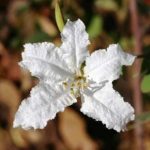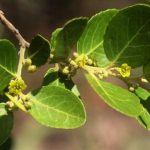TREE LIFE
SEPTEMBER 2001
MASHONALAND CALENDAR
Tuesday 4 September Botanic Garden Walk Meet in the car park of the Botanic Garden at 4.45 for 5 pm where we will meet Tom and continue with the Figs.
Sunday 16 September. This is another new venue for us in the Raffingora farming area. The Duffield family will be our hosts on their farm near the Mazwikadei Dam. Dave has done a recce and located an interesting site for us.
Saturday 22 September Mark’s next walk will be in Christon Bank.
Tuesday 2 October Botanic Garden walk
MATABELELAND CALENDAR
No arrangements have been made for September. Contact Jonathan Timberlake if you would like to organize a future outing.
Beatrice – Sunday 15 July 2001 Alamein Farm
Our late arrival at the Watson-Smith’s farm (11 300m; 30″ annual rainfall, edge of Kalahari sandveld) was marked by acknowledgement from the party of neo-colonialists sipping tea and munching cinnamon cookies on the lawn of the farmhouse. Thankfully, they had left a few bikkies and egg sarmies so we soon settled in. However, at Mark’s rallying cry we gathered together, with yours truly volunteering to provide this written account after the rabble had quietly dispersed when he started looking for a scribe. First a quick walk or drive to the “Pavilion” which looked out over the dam and then we were off to see how good our leaders were at identifying leafless trees.
“I think it’s a Ziziphus; no maybe a Grewia – or it could be Pseudolachnostylis; maybe a Combretum colinum – but the fruit on the ground means it must be C. zehyrii?!” A few minutes of this was enough to convince the masses that we should move on to where there was the promise of at least some partial foliage to aid in identification. Many of the shrubs had been heavily browsed by the wildlife who obviously wanted to reduce our chances of success. The eland in particular must be castigated for the physical damage they had done to the young trees.
Would that we were giraffes or that someone had been brave enough to scale the magnificent Acacia – then we could have got a foliage sample to help determine whether it was A. sieberiana or A. polyacantha. Based on the fact that there was some papery bark on the new growth, it was eventually announced to be the former -even though (or perhaps because?) a few metres away was another which showed the papery appearance from grass level upwards. Nearby was a tall Cassine which, again in the absence of anyone with 3m long arms, had to remain unspecified. To try and remove the crick in one’s neck, creeping along the ground were Syzygium guineense (readers to check with someone knowledgeable that I got the right species and as to the subspecies) and Parinari capensis with a miniature Ochna species assaulting the ankles.
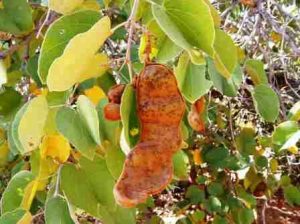
Piliostigma thonningii. Photo: Mark Hyde. Source: Flora of Zimbabwe
There were various Piliostigma thonningii (monkey bread tree) scattered around. To you and me these are Bauhinias with the characteristic butterfly-shaped leaves, but we were reminded that they had been separated from this genus due to floral differences and to the fact that their large pods are indehiscent (don’t break open) unlike true Bauhinias. Amongst these trees we found Maureen violently attacking a leafless sentinel – this most unbecoming behaviour was apparently in an effort to extract a milky sap from the poor individual. Despite inconclusive results from her endeavours, we decided that the grey, fluted bark and pulled toffee appearance was typical of Commiphora mollis. There was also a magnificent specimen of Adenia gummifera, a woody climber with a greenish bark with black striations. The Gardenia volkensii had been heavily browsed but the tongue-test (smooth leaves) helped identify them. As with other Rubiaceae, these plants showed whorled or opposite branching and leaf arrangement (not to forget the interpetiolar stipules of course). Parinari curatellifolia (mbola plum), Euclea divinorum, Acacia amethothophyla (the long-leafed acacia with an even longer name) and Burkea africana were also spotted.
On our stroll across to a patch of what we were promised was Brachystegia woodland – we did finally find some msasas (Brachystegia spiciformis) and mhnondos (Julbernardia globiflora) – Mark pointed out one of the finds of the day. This was a rather unhappy specimen of Terminalia brachystemma. This species possesses peeling twigs (as do T. sericea and T. trichopoda) and has sessile and hairless leaves. According to Gelfand (1985), T. brachystemma bark is commonly employed in traditional remedies for diarrhoea with the roots used more rarely for other complaints. Not far off was another unusual sight for us, Strychnos pungens. For those who paid attention, we were reliably informed that the pungens does not refer to any smell, but rather the unpleasant experience of coming into contact with the spine-tipped glossy leaves (yes, they had 3 veins from the base of the leaf as do other Strychnos species).
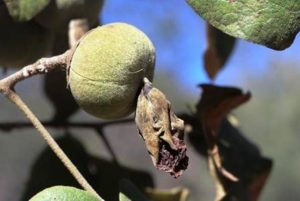
Azanza garkeana. Photo: Mark Hyde. Source: Flora of Zimbabwe
Finally making into the semi shade of the woodland, we managed to make some headway in species identification. Sadly, this coincided with me beginning to drift in concentration. However, I do remember the Ochna pulchra with its smooth bark at the top and rough bark below, Erythrina abysinnica (coral or lucky-bean tree) just beginning to flower, Azanza garkeana (snot apple or African chewing gum) which had become “bonsaied” due to heavy browsing, Diospyros lycioides, Grewia decemovulata and a strange example of a Vitex or a Rhus which had a selection of simple and trifoliolate (See, I did read the past few issues of Tree Life! – leaves with 3 leaflets) leaves on its branches. Not wanting to short-change you too much in this account, I pumped Rose for a few more species that Mark had pointed out. She assured me there had been a Schotia brachypetalaand a Ficus sur (Cape fig). I was going to ask her which were the trees with the red bark when I realized that it was just the labour of hard-working termites.
Guy obviously hadn’t been briefed on the sedentary nature of Tree Societes – he led us off at a brisk pace for what seemed like miles to investigate some anthills. I thought we were after a view of his Colophospermum mopane (mopane) trees but we saw nary a one. Instead there was Pavetta schumanniana with the black bacterial nodules in its ribbed leaves and a rather startled praying mantis hanging on to the simple of foliage for dear life. I thought I had spotted Maytenus senegalensis until Mark reminded me that it is now called Gymnosporia senegalensis. A Brachystegia boehmii (Prince of Wales feathers) and a few Ozoroa insignis were also to be seen. I should also mention there were various examples of Kigelia africana, the sausage tree, some with their large elongated fruit. Cosmetics with extracts of this fruit are being increasingly promoted as skin healers and rejuvenators despite a lack of scientific evidence to support this. However, I suppose it is no worse than the traditional belief that it will have a “beneficial” effect on a part of the anatomy of young males that vaguely resembles the whole fruit, at least at times. No scientific evidence to support that belief either.
Time for lunch so back to the Pavilion past the stunted and rather out of placeFaidherbia albida which a wily Guy had obviously planted there some years ago in anticipation of our visit just to throw us off. Before we were allowed to tuck into our packed rations, we were whisked off to view a remarkably large specimen of Vangueriopsis lanciflora. Personally, I found the drive through the wildlife section far more entertaining than a 5 metre bare tree – I wish we had a back yard with eland, wildebeest, tsetsebe, bush goats (sorry, impala!) sable, giraffe. A good time was had by all and I’m sure we’ll have lasting memories – aided and abetted by the pepper ticks!
-Douglas Ball.
THE ECOLOGY OF THE IRONWOOD – ANDROSTACHYS JOHNSONII.
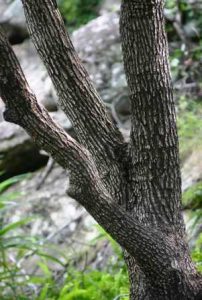
Androstachys johnsonii. Photo: Bart Wursten. Source: Flora of Zimbabwe
The distribution of this tree in Zimbabwe is restricted to the lowest and hottest parts of the South East Lowveld. It also extends into the border areas between Mozambique and South Africa and Swaziland where the ecology is similar.
In 1972 Allan Wright’s book entitled ‘Valley of the Ironwoods’ was published. It was a long account of his experiences in Government service as District Commissioner at Nuanetsi in the years when the Gonarezhou National Park was being formed. Sadly the book, despite its title, presents little of ecological value on the occurrence of this interesting species although it did make some of us realize that there was another hard durable wood in the Lowveld apart from Leadwood (Combretum imberbe) and Mopani (Colophospermum mopane).
My first encounter with it was on Hippo Valley in 1958 when we collected dozens of poles of this tree from local sandstone ridges to be used as supports for irrigation hydrants in the newly planted citrus groves. The vernacular name for the species is Musimbiti which translates into the English, Ironwood and Afrikaans, Ysterhout. The reputation of the durability of Musimbiti poles for fencing or construction work was unsurpassed. The wood is hard and springy and is not damaged by termites or wood rots. Typically it occurs in thickets on sandstone outcrops where the grass cover is so poor as to preclude any veld fires. The wood burns easily with a waxy smokey flame and can be used as a torch but the wood is not used readily as a cooking fuel. I would like to wager that those posts we cut over 40 years ago are still in good working order and have outlasted the citrus trees.
Musimbiti is very sensitive to cold and it only occurs in warm localities free of frost, hence its restriction to the hotter parts of the lowveld. It is also drought tolerant in that it grows on cretacious sand ridges with a very small water holding capacity in a zone which receives less than 500 mm of rain on average per annum and which is subject to very hot and evaporative weather for most of the year. Deciduous, the leaves are dark green and shiny above and are covered in white felt like hairs on the undersurface, characteristics which assist in withstanding drought stress. Drought stress is a common feature of the southern african ecology but much of the drought-stricken regions are also subject to intense cold seasonally. It is only those hot and arid parts of the lowveld that are suitable for this species.
There is an interesting spot on the plateau above the Chilojo Cliffs on the lower Runde river where Androstachys johnsonii and Brachystegia spiciformis can be seen growing side by side. The normal habitats of these two species are sharply contrasting, Msasa being best suited to fertile well drained soils of the higher rainfall areas where it withstands moderate frosts and is hardy against veld fires when the rank grass burns each year, while the Musimbiti is drought tolerant, grows on very thin sands and requires protection from fire and freedom from frost. The answer to the riddle lies in the fact that the soil in this particular place is a very deep structureless cretaceous sand where none of the meagre rainfall runs off but is available at depth in sufficient quantities for the Msasa to endure. The moisture reserves in the upper horizons of the soil are poor, however, resulting in a weak grass cover with no threat of damaging fires which suits the Musimbiti. The locality is generally hot and free of frost.
Musimbiti does not occur in the dry regions in the west of the country, despite its drought tolerance as frost is common in those areas but more perplexing is the question as to why it does not occur in the lower Zambesi valley where frost does not occur. I assume this is because the rainfall is often plentiful in season and the soils are periodically waterlogged, as well as the fact that grass growth is usually vigorous and veld fires are common and damaging.
In the 1960’s it was official Government policy in the lowveld to clear belts free of trees to prevent the spread of tsetse fly as the fly was known to prefer a shady habitat. The Musimbiti thickets were suspected as being particularly favoured and bulldozers were employed to clear these strips in parts of the Gonarezhou. However, the bulldozers were soon immobilised in these thickets as the felt like hairs on the leaves clogged the radiators. Work only proceeded when the radiators were screened effectively to keep the hairs out.
The tree clearing policy was soon abandoned in favour of pesticides sprayed from the air. And so the Musimbiti remained.
Elephants browze the species; it is not uncommon in the Gonarezhou to find thickets of Musimbiti heavily knocked about by elephant to the point of devastation yet it seems able to survive.
I once attended a public address by a Archeologist who had found a sliver of wood in his excavations in Swaziland which was identified as Musimbiti. It was fashionable at that time to attempt to relate one’s research to climatic variance and prediction as the land had recently experienced some serious and damaging droughts. This strategy could sometimes improve the chances of additional finance to support the research and the speaker in this case concluded that the locality must have been subject to serious droughts in the past following the presence of the Musimbiti sliver. I felt uneasy with his conclusion because in my opinion it did no more than suggest that the sliver originated in a place free of fire and frost and it was not necessarily an indicator of previous severe droughts.
My interest in the species stems in the main from the very specific and limiting ecological conditions in which it can thrive. It so happens that the suitable habitats occur in remote, but interesting and often picturesque places, which makes it even more of a favourite!
-John H Wilson
I refer to Tree Life No. 257, July 2001, page 9, In Retrospect, Lyn Mullin, New Finds in Chizarira National Park. A Rootnote from Kim Damstra in Tree Life No. 86, April, 1987.
The name Anthocleista grandiflora (big leaf) brought back memories. In November, 1968, Jordy Jordan, a National Parks Officer and I found this species on the Busi River 12 kilometres northeast of the Branch of Tsetse and Trypanosomiasis Control’s Lusulu field station at a point where the Chizarira National Park southern boundary crosses this river. The plant took the form of about a three metre high, rather spindly looking tree which was growing in a cleft of a sandstone outcrop forming one of the banks of the Busi River. We only collected a very small branch of the tree because of its rather frail nature. We did not want to damage it. Neither of us had ever seen the tree previously in the Chizarira area and felt it looked interesting. I returned to Harare that evening by charter aircraft and had the specimen identified at the National Herbarium the following day. I advised Jordy in writing of the result on 15th November, 1968 making the comment “it is of interest to note that it is an Eastern Districts species and therefore rather unusual in the locality in which we found it.” Using the map references given in Kim Damstra’s note, it appears that the “Lost Valley” where Dr. Colin Craig found Anthocleista grandiflora, as reported by Kim Damstra, lies within the Busi River drainage.
Desmond F Lovemore.
In Retrospect – Lyn Mullin
MSASA SPRING COLOURS
In a ROOTNOTE in TREE LIFE No.79 (September 1986), Kim Damstra answered the question: why are the spring colours on the musasa (Brachystegia spiciformis) so vastly different on groups of trees growing on exactly the same type of soil, and under the same weather conditions?
Before answering that question, perhaps we should analyze the colours themselves. Leaves are usually green in colour due to the pigment, chlorophyll, which is able to capture the energy in red light, and use it to convert water and carbon dioxide into sugar. Plants exposed to bright sunlight often protect the chlorophyll by producing a red pigment, anthocyanin. This is most clearly seen in many of the succulents that are bright red when kept in full sunlight. If moved into the shade the plants stop making anthocyanins, and the leaves become green. New leaves may also benefit from the protection of the anthocyanin pigments, and so a number of plants produce bright-red, young leaves, and these include the musasa. As everyone knows, the leaves start off bright scarlet or deep red, and then change colour to orange; gradually more green is added until the leaves are apple-green. They then deepen to dark green. This provides the first half of the answer – different trees start to flush on different days, and so they are all at a different stage at any one particular time. Why are they staggered? It’s simply a genetic difference. Jack and Judy Reid observed that one particular tree would flush at the same time every year. We may well ask why don’t they all flush together? Well, there are advantages to flushing early, and advantages to flushing late. Trees that flush too early may be caught out by a late frost that damages the spring leaves. At present the large Milicia excelsa on the lawn opposite the pond in the Botanic Garden has been frosted in this way. But trees that flush too late may lose out on valuable time required to ripen their fruit, or to trap more energy to grow more. As the seasons vary, so the optimum strategy must vary – some years the early-flushing trees benefit; other years they are frosted and the late-flushing trees benefit.
The second point is that the amount of anthocyanin each tree produces varies from individual to individual. This is also controlled genetically.
These two factors combine to produce the splendid array of colours that excites us all so much during August and September.
[Comment 2000: Kim’s second point, the natural, genetically controlled, tree-to-tree variation in musasa is a very important one, and one could imagine some enterprising person using this variation in a musasa breeding programme to select for different spring-flush colours.Has anyone noticed that most of the musasa within the city boundaries of Harare have a very disappointing spring flush? They are not nearly as bright as their country cousins, which raises the question: is their ability to produce anthocyanin being impaired by vehicle-exhaust fumes and other, industry-generated, atmospheric pollution? Food for thought – and debate!]
To be continued:
Adapted with thanks from Trees in South Africa Oct-Dec 1969.
THE STORY OF QUININE PERUVIAN BARK – THE CINCHONA TREE
‘A tree grows which they call the fever tree, whose bark, the colour of cinnamon, made into powder amounting to two small silver coins and given as a beverage, cures the fevers; it has produced miraculous results in Lima.’ – from the Journal of an Augustinian monk (1633)
About the year 1630 news trickled into the European world via Spain that an infusion of bark from an unknown tree in the remote land of Peru cured malaria.
This dread disease had ravaged most countries of the world for over 3000 years causing more deaths than any other disease.
Bark from a tree in a distant jungle! A remedy for malaria! Doctors regarded this incredible story with scepticism and contempt. So strong was the opposition that more than 150 years were to elapse before the drug, quinine, extracted from Cinchona tree bark, was recognised as an effective cure for malaria.
To the Jesuit missionaries in Lima, the capital of Peru, goes the credit for the introduction of ‘Peruvian Bark” into Europe. Living and working among the Indian peoples of South America, Jesuits learned the medicinal value of the bark of the Quinquina tree, as the Indians called it, and passed on the knowledge. Due to their efforts bark was collected and shipped to Spain – no easy task 300 years ago – and was used, despite medical opposition, to relieve malaria. The crushed bark came to be known as “Jesuits’ Powder”.
The home of this rather insignificant tree is in the Amazonian forests of South America on the eastern slopes of the Andes, the great chain of lofty mountains that runs almost the entire length of the continent. On the steep slopes of snow-clad peaks often obscured by mist, a dense jungle of vegetation stretches for thousands of miles, broken only by winding tributaries on their way to join the mighty Amazon on a 4000-mile journey to the Atlantic Ocean.
Linnaeus gave to this Peruvian tree the name Cinchona after the Count of Chinchon, Viceroy of Spanish Peru in the early part of the 17th century. The tree belongs to a well-known family (Rubiaceae) of plants useful to man -. One of the best-known is Coffee; another is Madder, from the roots of which a fine dye is produced. For many years this dye was used for colouring the uniforms of the British Army. But the drug quinine superseded in value both these in providing the means whereby man could work and fight in a malaria-ridden country.
In the moist, tropical forests of the Andes where mosquitoes, snakes, spiders and other hazards abounded, the forest Indian searched for the Cinchona tree. The difficulties involved in procuring the bark were great. Shipments of it nevertheless continued to find their way to Europe. At first bark was obtained from felled trees; later it was stripped with machetes from living trees which, however, subsequently died. And, as the trees became scarcer, the bark-collectors were compelled to penetrate every deeper into the forest, toiling wearily through the trails they cut and over the mountain passes or navigating up and down the dangerous rivers.
From time to time warnings were sounded against the methods of harvesting the bark involving the destruction of the trees. “Though the trees are numerous they have an end”, wrote Antonio Ulloa in 1735 . “Wholesale bark-stripping which of course killed the tree must be followed by planting a new one”, commented the Jesuit missionaries. These ominous warnings went unheeded for many years.
If you have wandered through the main streets of Paris you will have come upon Boulevard St. Michel, and will have seen the statue erected to the memory of the two French chemists who, in 1820, isolated from Cinchona bark the alkaloid responsible for the treatment of malaria. This feat was hailed with enthusiasm throughout the world. Malaria therapy could now be standardised by the use of the drug quinine, so called after the Indian name for the tree.
The demand for the bark increased greatly. Supplies began to diminish and yet 30 more precious years passed before steps were taken to cultivate Cinchona purposefully. In 1852 the Dutch Government, mindful of their malaria-infested territories in the Dutch East Indies, sent a botanist to Peru to collect seed and plants for cultivating. Plantations were established in Java, but only after many years of trial and error did Dutch horticulturists succeed in raising the right species of Cinchona to produce a high yield of quinine in its bark. Later, these plantations captured the world market in quinine.
Five years later the British followed the example of the Dutch. An expedition was sent to Peru and the seed thereafter planted in India and Ceylon where malaria was also a great problem.
Quinine is still an important drug in the treatment of malaria despite the synthetic compounds now used to combat the disease. Due to effective modern control measures such as spraying mosquito breeding places, malaria is on the wane and less drugs have become necessary.
Early Voortrekkers in the Transvaal were much troubled by malaria, recalling how the little town of Ohrigstad was abandoned because of the disease. Malaria Research Stations in South Africa have, however, done much to overcome the disease.
There are a number of plants of the Cinchona family – Rubiaceae – in South Africa one of them being the Wild Gardenia. This small tree is often seen in the Game Reserves and the rest camps there. It is remarkable to note that some of the African people actually make an infusion of the roots of this Gardenia as a remedy for malaria!
-Gertrude Ordman
THE OAKS AT RHODES HOTEL
The night of August 15th [1899] I stayed with Mr. Norris at Rhodes’s farm, where the cosy dining-room with thick European walls, and a cheerful fire in the grate, made me feel especially comfortable. CARL PETERS (1902) –
THE ELDORADO OF THE ANCIENTS
It was in 1896 that Cecil John Rhodes first visited the Nyanga district, and so impressed was he with it that he immediately asked his close associate, James Gordon McDonald, to arrange the purchase of up to 100 000 acres (40 500 ha), “and be sure you take in the Pungwe Falls. I would like to try sheep and apple growing”. McDonald was able to carry out his request, and so was born the Rhodes Inyanga Estate which was eventually bequeathed to the country as a national park.
John Grimmer, one of “Rhodes’s Young Men”, had charge of the estate for a short time, but it was John Norris, one-time valet to Rhodes at Groote Schuur in the Cape, who must be credited with getting the farming and fruit-growing operations started. Norris arrived at the estate late in 1896, and by the middle of 1899 he had established fairly extensive orchards of deciduous fruits – even some citrus, which was quite unsuitable for the local climate.
The farm homestead became the nucleus of today’s Rhodes Hotel, and among the trees planted near the old homestead was an avenue of English oak, Quercus robur. There is no certainty about the planting date, but it was probably during Norris’s time as manager, before Rhodes’s death in 1902, and they were possibly the first oaks in Zimbabwe. Most of them still stand there today, and although nearly all have been retarded by the eucalypts that tower over them from across the road leading to the hotel, the two nearest the hotel reached a respectable size, despite being short-boled. In April 1987 the largest of these was 26 metres tall, with a diameter at breast height of 1.46 metres and a crown spread of 27 metres. The next tree in the avenue was slightly smaller in diameter, but its height and crown width were much the same as those of the first. Sadly, the larger of these two trees was destroyed in a storm in February 1988.
The English oak is out of its element in Zimbabwe, and is never likely to reach the great sizes it does in its native habitat, where it sometimes attains a height of 45 metres, with a clear bole of 20 metres. Old, open-grown trees may have massive trunks more than 3 metres in diameter. To the Druids of Celtic Britain it was a sacred tree, and they gathered mistletoe from its boughs for their religious rites. Oaks have a long history in mythology – in Ovid’s Metamorphoses there is the account of Philemon and Baucis, who entertained Jupiter and Mercury when everyone else refused them hospitality; their request to die at the same time was granted, and when they were very old Philemon was changed into an oak and Baucis into a linden tree. In Greek mythology oaks were associated with Zeus, the god of thunder, and were believed to be more susceptible than other trees to being struck by lightning – even in Shakespeare’s King Lear there is reference to “oak-cleaving thunderbolts”. Perhaps, as is so often the case, this myth had some real basis in fact, for the oaks would often be the tallest trees around and therefore the most likely to be struck.
Lyn Mullin
MARK HYDE CHAIRMAN


